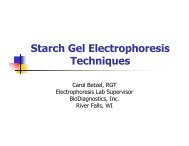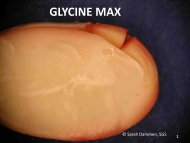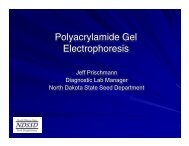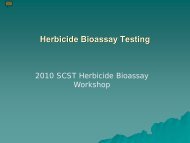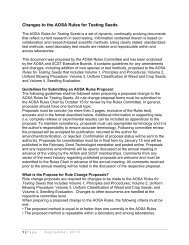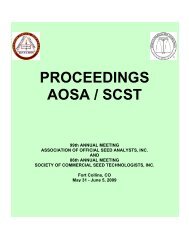Agarose Gel Electrophoresis
Agarose Gel Electrophoresis
Agarose Gel Electrophoresis
You also want an ePaper? Increase the reach of your titles
YUMPU automatically turns print PDFs into web optimized ePapers that Google loves.
<strong>Agarose</strong> <strong>Gel</strong><br />
<strong>Electrophoresis</strong><br />
Jeff Prischmann<br />
Diagnostic Lab Manager<br />
North Dakota State Seed Department
<strong>Agarose</strong> <strong>Gel</strong><br />
<strong>Electrophoresis</strong><br />
Backround<br />
Preparing and Running <strong>Gel</strong>s<br />
Troubleshooting
<strong>Agarose</strong> <strong>Gel</strong>s<br />
<strong>Gel</strong> matrix is formed from the use of<br />
agarose. A highly purified form of agar<br />
which is isolated from seaweed.<br />
<strong>Agarose</strong> gels are primarily used for the<br />
separation of RNA/DNA molecules.<br />
Allows the for the separation of large<br />
molecules.<br />
The preferred gel type to separate larger<br />
DNA fragments > 1000 bp.
<strong>Agarose</strong> <strong>Gel</strong>s<br />
<strong>Agarose</strong> is a polysaccharide made<br />
up of agarobiose.<br />
Source: National Diagnostics
<strong>Agarose</strong> <strong>Gel</strong>s<br />
<strong>Agarose</strong> gel matrix is composed of linear<br />
chains of agarobiose which are held<br />
together by hydrogen bonds.<br />
This structure allows agarose gels to be<br />
easily made and poured.<br />
Denaturing and native run conditions can<br />
be used.<br />
Typically run using a horizontal gel<br />
apparatus (submarine type).<br />
<strong>Gel</strong>s down to 0.5% agarose can be<br />
prepared.
<strong>Agarose</strong> <strong>Gel</strong>s<br />
<strong>Agarose</strong> gels have large pore sizes<br />
(much larger than polyarcylamide gels).<br />
Lower resolution than polyacrylamide<br />
gels.<br />
<strong>Gel</strong>s can be prepared very quickly.<br />
Safer and easier to handle compared to<br />
acrylamide gels.<br />
Small DNA fragments (< 400 bp) or<br />
proteins are not usually separated using<br />
agarose gels.
<strong>Agarose</strong> <strong>Gel</strong>s<br />
Effective separation ranges for<br />
agarose gels:<br />
% gel size range (bp)<br />
2.0 200-3000<br />
1.75 250-4000<br />
1.5 300-5000<br />
1.0 400-12000<br />
0.75 1000-23000
<strong>Agarose</strong> <strong>Gel</strong>s<br />
Size resolution: a difference of<br />
approx 5% in fragment size can be<br />
resolved (50 bp difference in 1000<br />
bp DNA fragment).<br />
In contrast, polyacrylamide gels<br />
have resolution down to 0.1% (1<br />
DNA base in a 1000 bp fragment).
<strong>Agarose</strong> <strong>Gel</strong>s<br />
Steps in <strong>Gel</strong> Preparation<br />
Clean and dry the gel mold and<br />
combs. On horizontal gel units, seal<br />
the gel mold ends using gel tape.<br />
Select appropriate buffer (TBE or<br />
TAE).
<strong>Agarose</strong> <strong>Gel</strong>s<br />
Steps in <strong>Gel</strong> Preparation<br />
Casting gel: add appropriate<br />
amount of agarose, buffer, and<br />
water to a flask and mix throughly.<br />
Heat using a microwave to dissolve<br />
the agarose ( time may vary<br />
depending upon microwave).
<strong>Agarose</strong> <strong>Gel</strong>s<br />
Steps in <strong>Gel</strong> Preparation<br />
Heat until no visible agarose<br />
particles are present.<br />
Add water to return to original<br />
volume or weight.<br />
Cool to 50-60 C.<br />
If necessary, add DNA dye to gel.
<strong>Agarose</strong> <strong>Gel</strong>s<br />
Steps in <strong>Gel</strong> Preparation<br />
Pour the gel solution into the mold.<br />
Insert gel combs.<br />
Allow gel to cool for at least 30<br />
minutes prior to use to complete gel<br />
formation.
<strong>Agarose</strong> <strong>Gel</strong>s<br />
<strong>Gel</strong> Preparation Example:<br />
300 ml gel volume<br />
1.5% agarose<br />
1X TBE buffer
<strong>Agarose</strong> <strong>Gel</strong>s<br />
<strong>Gel</strong> Preparation Example:<br />
4.5 g agarose<br />
30 ml 10X TBE buffer<br />
final volume = 300 ml
<strong>Agarose</strong> <strong>Gel</strong>s<br />
Many different gel mold sizes are<br />
available.<br />
Multiple gel combs can be used in<br />
the same gel.
<strong>Agarose</strong> <strong>Gel</strong>s
<strong>Agarose</strong> <strong>Gel</strong>s
<strong>Agarose</strong> <strong>Gel</strong>s
<strong>Agarose</strong> <strong>Gel</strong>s
<strong>Agarose</strong> <strong>Gel</strong>s<br />
Vertical slab submarine type<br />
electrophoresis apparatus.<br />
<strong>Gel</strong> mold sizes can vary.
<strong>Agarose</strong> <strong>Gel</strong><br />
<strong>Electrophoresis</strong><br />
Main Steps<br />
Prepare samples<br />
Prepare gel and buffers<br />
Load samples onto gel<br />
Run gel<br />
Stain gel<br />
Interpret/analysis of gel<br />
Archive (photograph)
<strong>Agarose</strong> <strong>Gel</strong>s
<strong>Agarose</strong> <strong>Gel</strong>s
<strong>Agarose</strong> <strong>Gel</strong>s
<strong>Agarose</strong> <strong>Gel</strong>s
<strong>Agarose</strong> <strong>Gel</strong>s
<strong>Agarose</strong> <strong>Gel</strong>s<br />
Running conditions<br />
<strong>Gel</strong>-loading buffers used in<br />
samples that contain dyes.<br />
Molecular weight markers<br />
typically ran with test samples.<br />
<strong>Gel</strong>s run 3-4 hr at 70V, RT.
<strong>Agarose</strong> <strong>Gel</strong>s<br />
Running conditions<br />
<strong>Gel</strong>s stained with DNA dyes after<br />
running (if dye is added to the<br />
gel prior to pouring, gel can be<br />
visualized directly).<br />
Visualization in approx 15-30<br />
minutes using UV light source.
<strong>Agarose</strong> <strong>Gel</strong>s<br />
Running conditions<br />
<strong>Gel</strong>-loading buffers include:<br />
bromophenol blue, xylene cyanol<br />
FF, and sucrose.<br />
<strong>Gel</strong>-loading buffers: increase<br />
density of the sample, add color<br />
to the sample, and contain dyes<br />
that migrate in electric fields at<br />
predicable rates.
<strong>Agarose</strong> <strong>Gel</strong>s<br />
Running conditions<br />
Bromophenol blue migrates<br />
through agarose gels at approx.<br />
2.2 times faster than xylene<br />
cyanol FF.<br />
Bromophenol blue migrates at<br />
approx. the same rate as dsDNA<br />
300 bp in length.
<strong>Agarose</strong> <strong>Gel</strong>s<br />
Running conditions<br />
Xylene cyanol FF migrates at<br />
approximately the same rate as<br />
dsDNA 4kb in size.<br />
These relationships are not<br />
significantly affected by agarose<br />
concentration.
<strong>Agarose</strong> <strong>Gel</strong>s<br />
DNA dyes<br />
DNA dyes include: ethidium<br />
bromide, Cyber gold, Cyber<br />
green, etc.<br />
Manufacturers of PCR reagents<br />
sell prepackaged buffers for<br />
PCR that contain dyes.
<strong>Agarose</strong> <strong>Gel</strong>s<br />
Applications<br />
Many types of nucleic acid<br />
separations.<br />
Commonly used for blotting.<br />
<strong>Agarose</strong> gels allow DNA<br />
fragments to be recovered.<br />
Pulsed-field gel electrophoresis
Troubleshooting<br />
‘Smiling’ gel front (center of gel running<br />
faster than either end; heat problem,<br />
buffer problem).<br />
Sample smearing or streaking (sample<br />
overload; problem with PCR reaction).<br />
Sample does not settle into well bottom<br />
(sample density problem).<br />
Skewed or distorted bands (poor<br />
polymerization around sample wells).
Troubleshooting<br />
Electroendosmosis (EEO) can<br />
cause problems with agarose gels<br />
during electrophoresis.<br />
EEO causes some gel ions to<br />
migrate towards the cathode<br />
causing gel smearing.<br />
Using high quality agarose can<br />
prevent this problem.
References<br />
Westermeier, R. 2001. <strong>Electrophoresis</strong>.<br />
Chapter 1. <strong>Electrophoresis</strong> in Practice. 3 rd<br />
Edition<br />
Sambrook, J. 2001. <strong>Gel</strong> <strong>Electrophoresis</strong> of<br />
DNA and Pulsed-field <strong>Agarose</strong> <strong>Gel</strong><br />
<strong>Electrophoresis</strong>. Chapter 5. Molecular<br />
Cloning: A Laboratory Manual. 3 rd Edition.<br />
National Diagnostics 2009-2010 Catalog<br />
(www.nationaldiagnostics.com)
Questions




